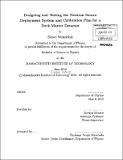Designing and testing the neutron source deployment system and calibration plan for a dark matter detector
Author(s)
Westerdale, Shawn (Shawn S.)
DownloadFull printable version (15.60Mb)
Other Contributors
Massachusetts Institute of Technology. Dept. of Physics.
Advisor
Jocelyn Monroe.
Terms of use
Metadata
Show full item recordAbstract
In this thesis, we designed and tested a calibration and deployment system for the MiniCLEAN dark matter detector. The deployment system uses a computer controlled winch to lower a canister containing a neutron source into the detector where the neutron source pulses to produce calibration data. The winch then pulls the neutron source back out of the detector. We found that the deployment system position is precise to under 0.05 cm, one tenth of the minimum required precision. We designed a canister that will hold the neutron source during the calibration process. The canister will contain a dielectric gel to thermally and electrically insulate the high voltage electronics and the neutron source from the rest of the detector. We calculated the equilibrium temperature change of the calibration neutron source when it is turned on and found that the temperature increases by 92.6+isi K, corresponding to a rise in the dielectric gel height of 1.501i.9 cm. This temperature change is within the service temperature range of the dielectric gel; however, a more thermally conductive gel could still be used to reduce the temperature increase. We simulate the background external neutrons in MiniCLEAN and find that the addition of an air-filled calibration tube to the basic MiniCLEAN design has little effect on the external neutron background rate. Lastly, we simulate the calibration process in order to determine how long we must calibrate MiniCLEAN in order to obtain the desired 5% statistical precision on measurements of the calibration neutron-induced recoil spectrum. We found that a minimum of 2.48x 106 neutrons are needed to measure the total counts in the region of interest in energy to 5% (corresponding to a pulse mode calibration time of 124 seconds assuming that neutrons are produced at a rate of 105 per second), and 2.02x 107 neutrons are needed to achieve 5% measurements of the energy spectrum with 2 KeVee binning in the region of interest (corresponding to a time of 1005 seconds).
Description
Thesis (S.B.)--Massachusetts Institute of Technology, Dept. of Physics, June 2011. "June 2010." Cataloged from PDF version of thesis. Includes bibliographical references (p. 113-116).
Date issued
2011Department
Massachusetts Institute of Technology. Department of PhysicsPublisher
Massachusetts Institute of Technology
Keywords
Physics.